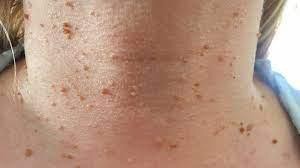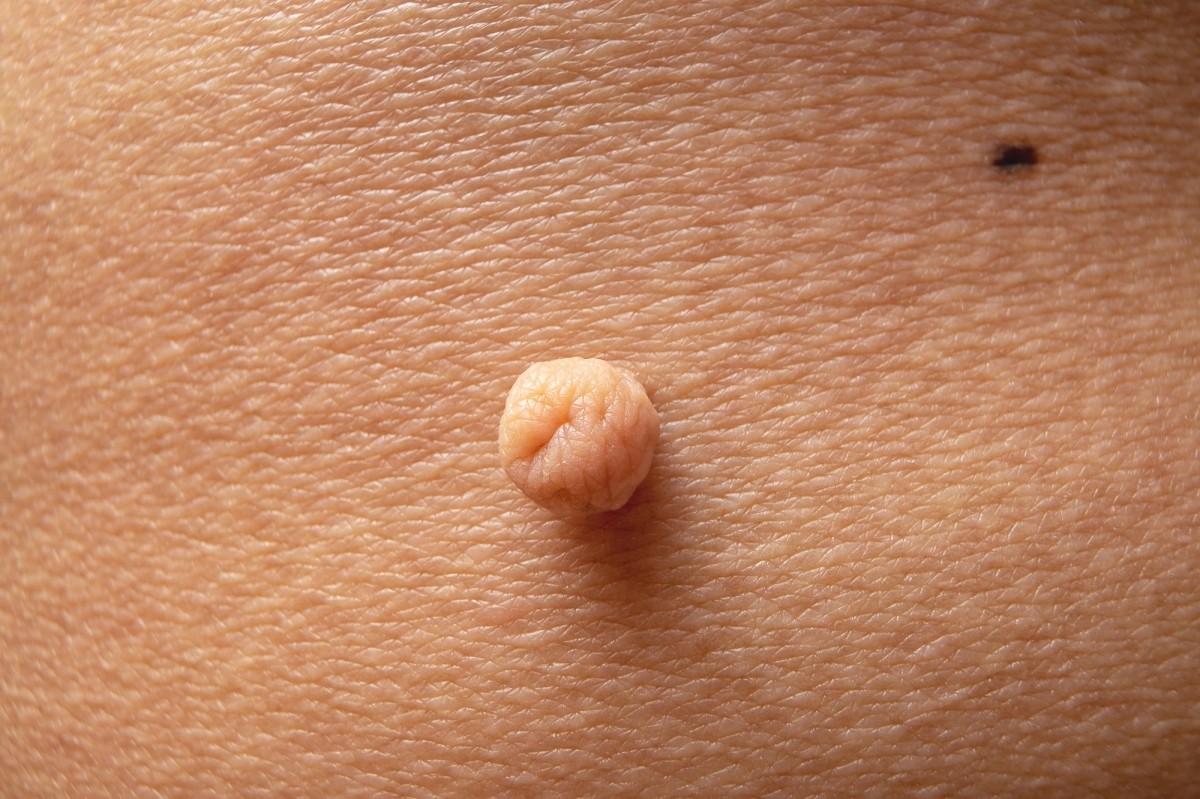Skin tags also called as acrochordons are small, noncancerous growths that tend to be the same color as your skin. Most skin tags are between 1-5 mm, but some can grow as large as a few centimeters. Skin tags are benign, noncancerous, tumors of the skin. They consist of a core of fibers and ducts, nerve cells, fat cells, and a covering or epidermis.


Skin tags are harmless growths that can appear anywhere on your skin, but often develop on the neck, eyelids, or underarms. They may be the same color as your skin or darker. Some are pink. Others turn red when irritated. You may see one dangling from a stalk, while another is firmly fixed to the skin.
Acrochordons are common and develop in both men and women as they grow older. Researchers estimate that half of all adults will have at least one skin tag in their lifetime. They tend to be more numerous in obese persons and in those with type 2 diabetes mellitus.
It is not known what causes skin tags. However, the following factors may play a role:
- Chaffing and irritation from skin rubbing together
- High levels of growth factors, particularly during pregnancy or in acromegaly (gigantism)
- Insulin resistance (syndrome X)
- Human papillomavirus (wart virus)
- Skin tags appear to be more common in:
- people who are overweight and obese
- those with diabetes
- women during pregnancy, possibly due to hormonal changes and high levels of growth factors
- those with some types of human papillomavirus (HPV)
- people with a sex-steroid imbalance, especially if there are changes in levels of estrogen and progesterone
- those whose close family members also have skin tags
- Studies have found that skin tags are more likely to occur with:
- obesity
- dyslipidemia, for example, high cholesterol levels
- hypertension, or high blood pressure
Identification of skin tags:
Skin tags are small, soft skin growths that look similar to a deflated balloon. They range in size with some as small as 1–2 millimeters and others as long as 1–2 centimeters (cm).
Skin tags also vary in appearance. Some have a smooth surface, while others have an irregular, bumpy texture. Most skin tags protrude from the surface of the skin on fleshy stalks. They can be flesh-colored, orange, brown, or dark grey.
People can develop multiple skin tags at a time. Some people may have three to four skin tags, while others can have 10 or more.
A skin tag is not painful or tender to the touch. However, constant friction from rubbing against other skin or clothing may cause it to bleed, swell, or feel itchy. These symptoms can also occur if a person catches a skin tag on jewelry or other objects.
Skin tags on the penis look similar to genital warts, which are soft growths that develop on the genitals. They occur when a person contracts a human papillomavirus (HPV) infection. HPV is a sexually transmitted infection (STI) that affects an estimated 79 million people in the United States.
Unlike genital warts and HPV, skin tags are not contagious. A person cannot transmit genital skin tags through sex with another person.
According to the World Health Organization (WHO), genital warts are moist, flesh-colored bumps that appear on the tip of the penis. A skin tag can appear on any part of the penis.
Skin tags often grow in these areas:






Other conditions might look like skin tags;
These conditions include:
- Moles.
- Warts, including genital warts.
- Skin cancer.
- Skin diseases like seborrheic keratosis, which causes wart-like spots.
No tests are necessary to confirm a skin tag diagnosis. If your healthcare provider suspects something else, they may take a sample (biopsy) and send it to the lab for testing.
Treatment:
There are many over-the-counter skin tag removal products. But at-home treatments are not safe. They come with a higher risk of complications, which include:
- Scars, Excessive bleeding, Infection, Incomplete skin tag removal, which means it’s likely to come back.
- Incorrectly using a tag remover on something that is not a skin tag, such as skin cancer.
- Damage to healthy nearby skin.
Dermatologists use:
Cryosurgery: During this treatment, your dermatologist applies an extremely cold substance like liquid nitrogen to freeze and destroy the skin tag. Sometimes, freezing causes a blister or scab. When the blister or scab falls off, so will the skin tag.
When using cryosurgery, your dermatologist may freeze only the bottom of the skin tag and then snip it off with a sterile surgical blade or scissors.
Electrodesiccation: Your dermatologist uses a tiny needle to zap the skin tag, which destroys it. You’ll develop a scab on the treated skin that will heal in one to three weeks.
Snip: Your dermatologist will numb the area, use sterile surgical scissors or a blade to remove the skin tag, and then apply a solution to stop the bleeding.
Ligation: Tying a wire around the base of the skin tag restricts its blood supply. Without adequate blood flow, the skin tag will die and fall off.
Cauterization: A doctor will burn off the skin tag using a small device called a cautery.
Preventive Steps for future skin tags include:
- Maintaining a healthy weight.
- Getting regular exercise.
- Avoiding jewelry and clothing that may rub against your skin.

